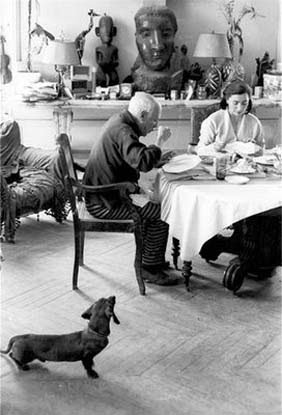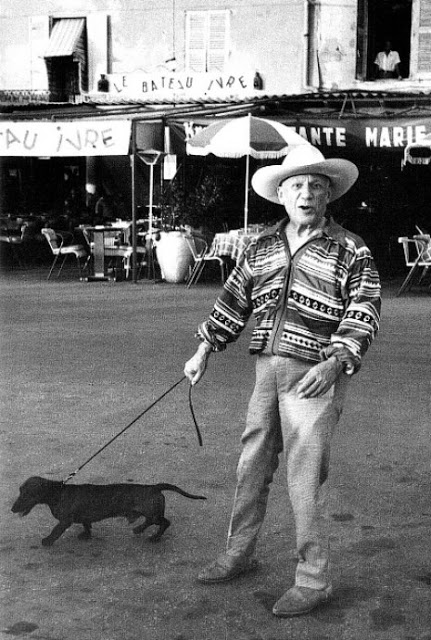 Arthur Miller and Marilyn Monroe together on the set of The Misfits (John Huston, 1961)
Arthur Miller and Marilyn Monroe together on the set of The Misfits (John Huston, 1961)
Originally written as a short story by Arthur Miller while awaiting his own divorce in Reno prior to marrying Marilyn Monroe. Director John Huston originally wanted Robert Mitchum to play “Gay Langland” but Mitchum didn’t like the script and turned it down. Huston and writer Arthur Miller rewrote the script, but by the time Mitchum got to see the rewrite he had committed to another film. The role was instead offered to Clark Gable, who took it.
Clark Gable’s close friend John Lee Mahin tried to dissuade him from making the film, insisting the part required a better actor like Spencer Tracy. Gable initially felt out of place since Marilyn Monroe, Montgomery Clift and Eli Wallach all practiced the Method, which was like an alien religion to him.
 John Huston, Marilyn Monroe, Montgomery Clift, and Arthur Miller on the set of The Misfits, 1960
John Huston, Marilyn Monroe, Montgomery Clift, and Arthur Miller on the set of The Misfits, 1960
On the last day of filming, Clark Gable said regarding Marilyn Monroe, “Christ, I’m glad this picture’s finished. She damn near gave me a heart attack.” On the next day, Gable suffered a severe coronary thrombosis. He died in hospital from a heart attack just ten days later.
This was the last completed film for both Marilyn Monroe and Clark Gable, her childhood screen idol. Gable died shortly after filming ended, and Monroe died of an alleged drug overdose over one year later. (Note: While Something’s Got to Give (George Cukor, 1962) is listed as her last film, it was never completed because she was fired.)
 Marilyn Monroe having her makeup touched up on location near Reno, Nevada, 1960
Marilyn Monroe having her makeup touched up on location near Reno, Nevada, 1960
Monroe was sinking further into alcohol and prescription drug abuse; according to Huston in a 1981 retrospective interview, he was “absolutely certain that she was doomed” while working on the film: “There was evidence right before me every day. She was incapable of rescuing herself or of being rescued by anyone else. And it affected her work. We had to stop the picture while she went to a hospital for two weeks.” Huston shut down production in August 1960 to send Monroe to a hospital for detox. Close-ups after her release were shot using soft focus. Monroe was nearly always late to the set, sometimes not showing up at all. She spent her nights learning lines with drama coach Paula Strasberg. Monroe’s confidant and masseur, Ralph Roberts, was cast as an ambulance attendant in the film’s rodeo scene
A doctor was on call 24 hours a day for both Marilyn Monroe and Montgomery Clift during the filming because both were experiencing health problems with alcohol and medical stimulants. This movie was on television on the night Montgomery Clift died. His live-in personal secretary, Lorenzo James, asked Clift if he wanted to watch it. “Absolutely not” was Clift’s reply, the last words that he spoke to anyone. He was found dead the next morning, having suffered a heart attack during the night.
Huston gambled and drank and occasionally fell asleep on the set. The production company had to cover some of his gambling losses. In a documentary about the making of The Misfits, Wallach told a story of Huston’s directing a scene in which Wallach was at a bar with Gable. Huston told him that the most intoxicated he had ever been was the day before, even though he had seemed sober. Huston’s lover, Marietta Peabody Tree, had an uncredited part.
Arthur Miller’s last play, Finishing the Picture (2004), although fiction, was largely based on the events involved in the making of The Misfits.
Finishing the Picture is a thinly-veiled autobiographical examination of the time Arthur Miller and his then-wife Marilyn Monroe spent shooting The Misfits. Miller and Monroe’s marriage was deteriorating at the time of shoot — the summer and fall of 1960 — due to her rampant drug abuse, her open infidelity with actor Yves Montand, and her panoply of mental illnesses. Also featured are characters that are closely related to real persons, including a film director reminiscent of John Huston, two acting teachers, clearly based on Monroe’s Actors Studio coaches, Lee Strasberg and Paula Strasberg, as well as the play’s screenwriter, based on Arthur Miller himself. In an interview conducted before the play’s debut, and published in the fall 2006 edition of the Arthur Miller Journal, actor Eli Wallach confirmed that one of the characters was most certainly based on his former Actors Studio colleague Lee Strasberg.
 Prince Philip, Duke of Edinburgh; Queen Elizabeth II. Photo by Terry O’Neill, 1992
Prince Philip, Duke of Edinburgh; Queen Elizabeth II. Photo by Terry O’Neill, 1992 English composer Benjamin Britten and “Clytie”.
English composer Benjamin Britten and “Clytie”.
 John F. Kennedy, Lem Billings and Dunker, Den Haag, The Netherlands, 1937
John F. Kennedy, Lem Billings and Dunker, Den Haag, The Netherlands, 1937 Lee Radziwill and Andy Warhol with his dog, Archie. Photo by Ron Galella, Montauk, 1973
Lee Radziwill and Andy Warhol with his dog, Archie. Photo by Ron Galella, Montauk, 1973 Christa Päffgen a.k.a. Nico. Photo: Mark Shaw for Life Magazine
Christa Päffgen a.k.a. Nico. Photo: Mark Shaw for Life Magazine Adele and “Louie”, named after Louis Armstrong
Adele and “Louie”, named after Louis Armstrong Vincente Minelli and Katharine Hepburn playing with George Cukor’s pet
Vincente Minelli and Katharine Hepburn playing with George Cukor’s pet Juliette Gréco. Photo by Robert Doisneau
Juliette Gréco. Photo by Robert Doisneau Jacques Cousteau, his wife and “Scaphandrier”
Jacques Cousteau, his wife and “Scaphandrier” David Hockney with Stanley and Boodgie
David Hockney with Stanley and Boodgie




 Pablo Picasso and Lump. Photographer David Douglas Duncan published a book of Picasso’s pictures along his pet, which was titled A Dachshund’s Odyssey
Pablo Picasso and Lump. Photographer David Douglas Duncan published a book of Picasso’s pictures along his pet, which was titled A Dachshund’s Odyssey The gardener and writer Christopher Lloyd at Great Dixter House, a 450-acre estate restored by Edwin Lutyens. Awarded in 1979 the Victoria Medal of Honour, the highest horticultural accolade, Lloyd was the best informed, liveliest and most innovative gardening writer of our times.
The gardener and writer Christopher Lloyd at Great Dixter House, a 450-acre estate restored by Edwin Lutyens. Awarded in 1979 the Victoria Medal of Honour, the highest horticultural accolade, Lloyd was the best informed, liveliest and most innovative gardening writer of our times. Within the Wall Garden of Great Dixter is a terrace, with a pebble mosaic of Christopher Lloyd’s two beloved dachshunds, Dahlia and Canna. The stones for Canna’s eye and nose were acquired from Derek Jarman’s rock-garden, at Prospect Cottage, in Dungeness.
Within the Wall Garden of Great Dixter is a terrace, with a pebble mosaic of Christopher Lloyd’s two beloved dachshunds, Dahlia and Canna. The stones for Canna’s eye and nose were acquired from Derek Jarman’s rock-garden, at Prospect Cottage, in Dungeness.



































 Simone Signoret and Yves Montand relax in the bungalow of their Beverly Hills Hotel, where they were staying while he was filming Let’s make Love with Marilyn Monroe.
Simone Signoret and Yves Montand relax in the bungalow of their Beverly Hills Hotel, where they were staying while he was filming Let’s make Love with Marilyn Monroe.














